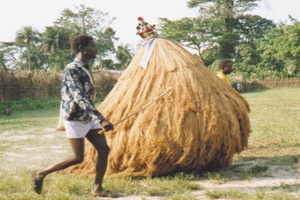Beginnings...
Williams College Music Season Opens with Music of the Haystack Period
By: Michael Miller - Sep 18, 2006
Beginnings...As far as I know, the term-time season in Williamstown began on Friday evening with a performance by the Williams Chamber Players, which consists of a changing group of members of the music faculty. They are much appreciated by local residents and faculty alike (Even a few students show up, even though Friday is a major party night.), and the rather claustrophobic Brooks-Rogers Recital Hall easily fills to capacity for these events.
This particular concert had a title, "Music in the Haystack Era." If any uninitiated person should, after blinking his eyes a few times, take this to be some arcane piece of Williams lore, he is pretty much correct. Any missionary enthusiast who is not a graduate of Williams College would have to be far advanced in his studies of the ABCFM (American Board of Commissioners for Foreign Missions) to connect it with a haystack which in August of 1806 stood on land now on the Williams campus. Furthermore, the idea of converting far-flung peoples to the Christian religion doesn't enjoy the cachet it once had (as we has recently learned), and Williams must have some postcolonialists hanging from its rafters. In any case, it is an even more formidable jump from this Yankee haystack to the world of Haydn, Mozart, and Beethoven.
This concert was intended as a celebration of the Haystack Bicentennial, and, as such, it was intended to offer music of the Haystack Period. Since nothing is known of musical life in the immediate environs of Williamstown in the first years of the nineteenth century, the three songs representing local musical practice came from contemporary sources associated more generally with rural New England, as Richard Giarusso explained in his engaging and well-researched introductory talk. Kerry Ryer-Parke, soprano; Brad Wells, baritone, and Keith Kibler, bass-baritone gave a spirited rendition of the unaccompanied part-songs, with which people entertained themselves in this agrarian region. Although all were grounded in religious sentiment, even the satirical "Complainer," I cannot say whether it would have been permissible to sing such songs on the Sabbath. These primitive compositions are fun to sing and to hear, but I can't say that I've ever heard such arid music from any corner of Africa, Asia, or anywhere else.
In the remainder of the program we were transported to a different world. I couldn't imagine what effect such music might have had on the pious frontiersman. The subtle harmonies and varied rhythms of both Haydn's Trio in C (H. XV:1) and the boisterous energy of Beethoven's Septet in E Flat, Op. 17 could well have seemed incomprehensible across the waters which separated Vienna from the New World. Some might even have perceived something devilish in the youthful Beethoven's frisky "Hausmusik."
It's curious, on the other hand, to note the relationship between the texts of the American songs with their Calvinist background, and "Our duty now we have performed, etc." from Haydn's "The Creation" and Papageno and Papagena's duet from "Die Zauberflöte," coming respectively from the English Enlightenment and Freemasonry. All include an optimistic gratitude for God's gifts in nature and a consciousness of man's secure place in it, justified by work and prayer. Looking back from our day, our perspective narrows the gap.
It's always a pleasure to hear the Williams faculty perform. Keith Kibler was both resonant and ebuillient as Papageno...and produced the only true pianissimo of the entire evening. In the Haydn Kerry Ryer-Parke showed her extreme delight in improvised ornament. Violinist Joanna Kurkowicz, cellist Ronald Feldman, and pianist Doris Stevenson played the Haydn Trio with energy, clarity, and a steady pulse—almost emphatically, and Beethoven's Septet came off in a similar spirit, with plenty of good cheer.
The hall acoustics, however, severely limited what these able musicians could achieve. Brooks-Rogers is undersized and rather dry in its sound. While the balance seems decent enough, everything is loud. It is extremely difficult if not impossible for musicians to play more softly than forte, much less pp, and strings must struggle to make themselves heard over a piano, even with its lid at the lowest position. It's surprising that an institution with such deep pockets as Williams, and one which offers its students such a rich music program, should slide by with such inadequate facilities. What's more the larger Chapin Hall, as handsome as it is, has even worse acoustic problems. The '62 Center for Theater and Dance, in which I reviewed a piano recital earlier in the summer, has quite good acoustics for solo piano, particularly from the despised second balcony. Perhaps this could serve a stopgap until the College decides to do something about its inadequate music facilities.
To close on a more cheerful note, Haydn was no stranger to haystacks. Following the success of "The Creation," he turned to the Scottish poet James Thomson's "The Seasons," which describes all the wonderful things that go on around them, in nature and among humans.
The best way to keep track of concerts at Williams is to check this page:
http://www.williams.edu/Music/public_events/main_calendar_frames.php


